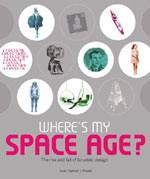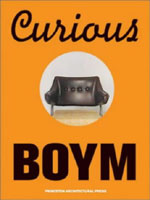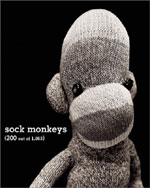Fly Me To The Moon
| |

| BACK TO THE FUTURE
One of the times I most remember from growing up was being woken up in the middle of the night to watch the first moon landing live on TV. We had the curtains open so we could see the real moon outside, as the black & white images flickered, buzzed and crackled after their minutes long journey back to earth. It was fantastic, and even now I find myself moved by hearing that ´one small step for man, one giant leap for mankind' recording. I wasn't alone in the late 60s with my childhood obsession. While the space race offered the world a rocket science future of chrome, steel and plastic, the hippies offered recycled art deco, velvet drapes, science fiction and soft curves; design and architecture was where it all came together. Where's My Space Age? The rise and fall of futuristic design [Prestel, ú22.95] comes suitably wrapped in pink plastic and silver ink. Groovy! Inside, Sean Topham has gathered a fascinating mix of impractical and practical space-age design. There's lots of pod housing, modular furniture, plastic chairs you wouldn't want to sit on, funky lighting, impractical imaginary towns, Smash monsters, and some more recent art including Yinka Shonibare's great alien family: a comic book nightmare brought to life as full-size sculpture. One of my great ideas when I was a kid was turning Guinness tankers into living spaces, connected by tubes and replacing their original lids with glass domes. [Okay, I admit there might have been some practical problems, not least breathing or how to get rid of the smell of fermented hops.] Anyway guess what, someone did it at the time! - sort of anyway. They sliced sections from the tanker, placed them a couple of feet apart in a row and lined them all with ribbed seating and a TV. Fabberoony! Or not. Actually it looks like something from 2001 a Space Odyssey and as uncomfortable as 3 week space flight surely was. But one thing that's clear from the book is there were a lot of innovative and practical ideas, particularly with regard to portable and temporary housing, that should have been acted upon. But as the book points out, somehow the space race seemed like an outdated and expensive idea: the optimism of the time turned into angst. The 70s were upon us, the space age was over, and we all put our toys away. |

| THE NEXT GENERATION
Andrew Collins was one of the next generation to me, although actually only five years separate us. But his hilarious book Where Did It All Go Right? Growing up normal in the 70s [Ebyr Press, ú9.99] shows how different it all was a few years later. For starters, there's little mention of the space race, and Collins' childhood obsessions and fads aren't mine. It's all trump cards, action man and space dust [OK, there's a space reference... and one of the few things we shared], as opposed to Hot Wheels, Thunderbirds, Battle of Britain film cards and small racing cars in bubblegum packs [I used to throw away the gum. The cards in the packs built up into a huge pit-stop/starting-grid scene to put the 24 cars on, four car designs in six colours. I had the full set, which I stored in a Milk Tray cardboard box.] Collins is different, too, in that he seems to have spent his childhood in a Northampton field, up to his knees in a stream or hiding in a den. I was in suburban London, though we did have a park up the road. But his book is full of the detail of childhood - comics read, adults observed and not understood, holidays undertaken, TV watched - that we all share and enjoy being reminded of. I never managed to keep a proper diary, but Collins not only did, he has them still: he offers us excerpts for our delight and amusement. The blurb on the back - ´They tucked him up, his mum and dad..' - says it all. This is a gentle, evocative meander through a normal childhood. Not exactly nostalgic [it's too genuine and honest for that] but full of wonderful reminiscences and recalled scenes, small truths and special moments recovered. It's also very funny. But I wish there'd been more about spacehoppers and skateboards. |

| CURIOUSER AND CURIOUSER
The space age may have been and gone, and Andrew Collins grown up to write his first book, but wacky design is still with us, as Curious Boym [Princeton Architectural Press, ú28] shows us. One of the blokes who've written blurbs on the back reckons ´the Boyms use irony, of which they are vastly endowed, without ever being arrogant or condescending'. He also says ´their designs are delicate and sensitive, and they all speak about the Boyms' sympathy and passion for the world of objects.' The other blurb writer, who I like even less [he bills himself as a ´very famous designer'], reckons the Boyms' work is ´a critique on the excesses of the twentieth-century mechanizations of production' and that they ´flirt with poetry'. Poetry my arse! They not only flirt, they passionately embrace and move in with with only one thing: kitsch. They recontextualise objects, they glue things together, and they make things from other things. They make little sculptures of damaged buildings, of missing buildings like the seven wonders of the world. But they're still horrible little dust-gathering objects for your mantlepiece! Making vases out of cups and saucers piled up, or pen holders from plastic plumbing is an art school project, not an ironic deconstruction of production! The space age design featured in Where's My Space Age? showed a flair and passion for materials and concepts that puts the Boyms to shame. Their work come across as shallow, detached and dull; just another postmodern joke. How very passé. Bring back retro. Or good old honest kitsch. |

| SOCK THE MONKEY
[apologies to Peter Gabriel] Well, actually, forget that statement about kitsch. One of the packets of cuttings, cards, catalogues and invites my friend Bob sent me a while back had a flyer for Sock Monkeys in, which prompted me to ask the nice people at Ideal World Books for a copy. The flyer amused me: portraits of weird monkeys made from socks, which are some kind of tradition in America. A thrift store soft toy, a home-made creature with chimp-like features and a range of natty hats and accessories. The flyer showed them piled high on chairs and tables in some kind of store room, with just a few photos; the tone appeared irreverent and witty. Which appealed to me. But the book itself [subtitled 200 out of 1,863] is kind of obsessive and dull; earnest, even. Even the one page interjections by the likes of Neil Gaiman, Teller and Robert Gl┘ck don't raise the tone. I'm desperate for some irony. Maybe I've just lost my sense of humour? Or maybe you have to be American and steeped in folklore and apple-pie traditions? Anyway, I'm beginning to see why they sent those monkeys into space. © 2003 Rupert Loydell 2003 |